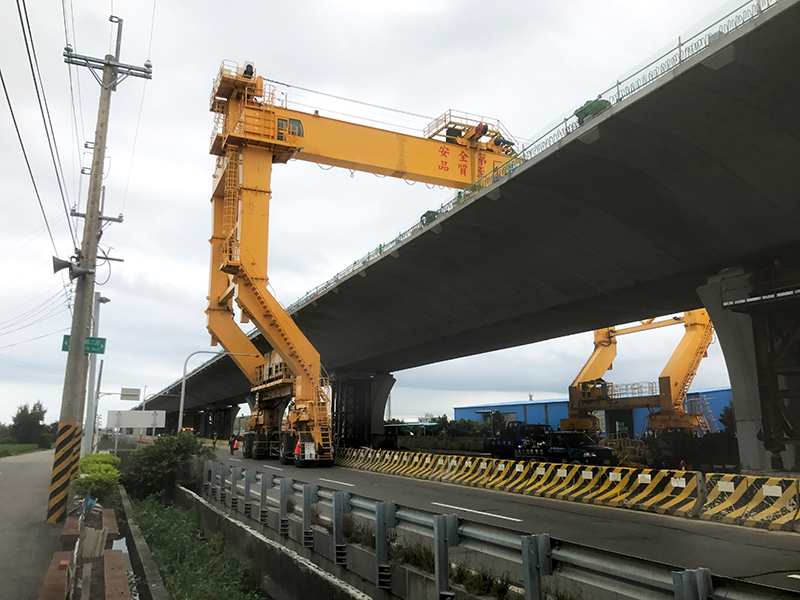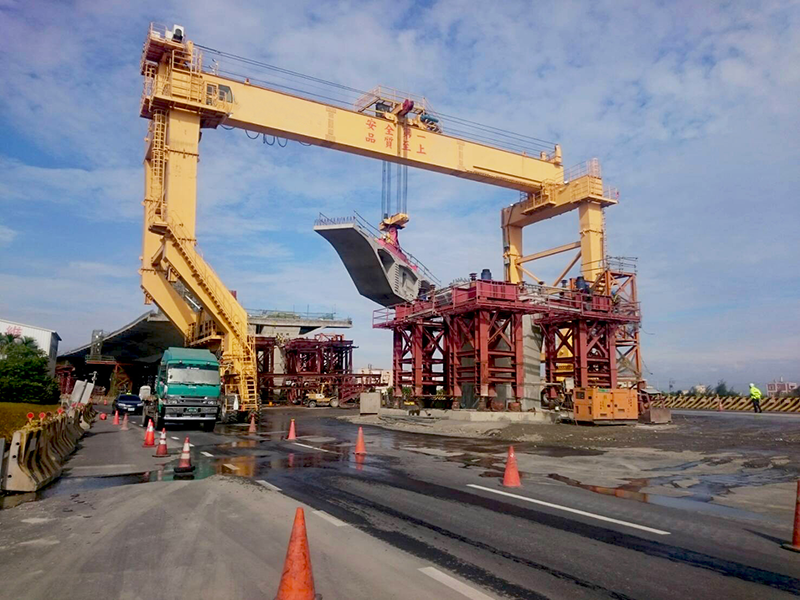In the realm of civil engineering and construction, the efficiency and precision of lifting heavy loads play a pivotal role in determining the success of a project. Gantry cranes have emerged as indispensable tools in bridge construction, facilitating the movement of materials with unprecedented ease and safety. This article provides a comprehensive overview of gantry cranes in the context of bridge construction, exploring their design, functionalities, advantages, and key considerations.

Bridge Construction Gantry Crane Design and Components
Gantry cranes, also known as portal cranes, are designed to straddle an object or workspace, providing both lateral and vertical movement of heavy loads. In bridge construction, these cranes are mounted on elevated tracks or runways, allowing them to traverse the entire length of the bridge structure. The primary components of a gantry crane for bridge construction include the main girder, end carriages, trolley, and hoisting mechanism.
Main Girder: The main girder serves as the backbone of the gantry crane, supporting the entire structure. It is typically composed of steel beams that provide the necessary strength and rigidity to lift heavy loads.
End Carriages: End carriages are mounted on the main girder and house the wheels that enable horizontal movement along the runway. The end carriages are equipped with motors and controls for precise positioning of the crane.
Trolley: The trolley is a movable component that travels along the main girder horizontally. It supports the hoisting mechanism and ensures the controlled placement of materials during construction.
Hoisting Mechanism: The hoisting mechanism, often consisting of a winch or electric hoist, is responsible for lifting and lowering loads. This component plays a crucial role in the safe and efficient handling of materials during bridge construction.
Functionalities of Gantry Cranes in Bridge Construction
Gantry cranes offer a range of functionalities that make them well-suited for bridge construction projects. The ability to travel horizontally along the entire length of the bridge provides a significant advantage in transporting materials and positioning them with precision. Some key functionalities include:
Material Handling: Gantry cranes excel in lifting and transporting heavy materials, such as precast concrete segments, steel beams, and construction equipment, across the bridge structure. Their versatility allows for efficient loading and unloading operations at various points along the construction site.
Assembly and Installation: Gantry cranes play a vital role in the assembly and installation of bridge components. Whether it’s placing structural elements or connecting segments, the controlled movement of the crane ensures accurate positioning and alignment during the construction process.
Versatility in Load Capacity: Gantry cranes come in a variety of configurations, allowing for customization based on the specific requirements of a bridge construction project. They can handle a wide range of load capacities, from smaller loads during initial construction phases to exceptionally heavy components in later stages.

Advantages of Gantry Cranes in Bridge Construction
The utilization of gantry cranes in bridge construction offers several advantages that contribute to project efficiency, safety, and cost-effectiveness:
Improved Efficiency: Gantry cranes enhance construction efficiency by enabling rapid and precise movement of materials along the bridge structure. This speed and accuracy are crucial in meeting project timelines and minimizing delays.
Enhanced Safety: The controlled movement of gantry cranes, combined with advanced safety features and operator training, significantly reduces the risk of accidents during construction. Safety considerations are paramount in bridge construction, and gantry cranes contribute to a secure working environment.
Customization for Project Requirements: Cranes for construction can be tailored to meet the specific needs of a bridge construction project. With various configurations available, including single or double girder designs, and different lifting capacities, contractors can select the most suitable gantry crane for their particular requirements.
Key Considerations in Gantry Crane Selection for Bridge Construction
While gantry cranes offer numerous benefits, selecting the right crane for a bridge construction project requires careful consideration of various factors:
Bridge Design and Dimensions: The design and dimensions of the bridge, including span length and width, influence the type and specifications of the gantry crane needed. Customization is crucial to ensure compatibility with the unique characteristics of each bridge.
Load Requirements: Understanding the weight and size of the materials to be lifted is essential in determining the appropriate gantry crane capacity. Overloading a crane can compromise safety and efficiency.
Site Conditions: The topography and conditions of the construction site play a significant role in gantry crane selection. Factors such as ground stability, elevation changes, and access points need to be considered to ensure the crane’s optimal performance.
Environmental Factors: Weather conditions and the potential exposure of the gantry crane to elements like wind and corrosive substances must be taken into account during the selection process. This consideration helps in choosing materials and coatings that enhance the crane’s durability.
Conclusion
Gantry cranes have become integral components of modern bridge construction projects, offering unparalleled efficiency, safety, and versatility. Their ability to handle heavy loads, navigate challenging terrain, and adapt to diverse construction requirements makes them indispensable tools for civil engineers and contractors. As technology continues to advance, gantry cranes will likely play an even more significant role in shaping the future of bridge construction, ensuring the timely completion of complex infrastructure projects around the world.
